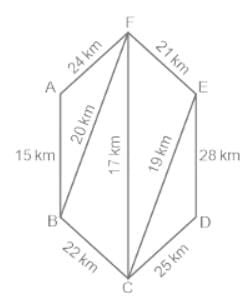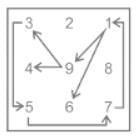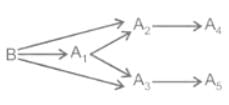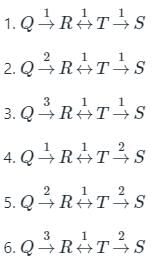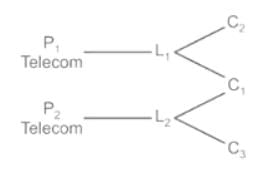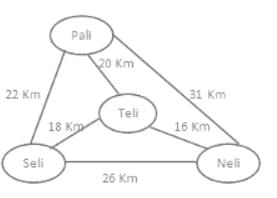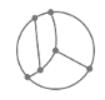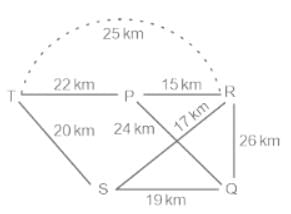Test: Routes & Networks - UPSC MCQ
10 Questions MCQ Test - Test: Routes & Networks
Punit lives in village A and want to visit nearby villages B, C, D, E and F. All villages are connected by two–way routes. The length of the route from A to B is 15 km, from B to F is 20 km, from F to A is 24 km, from F to E is 21 km, from C to F is 17 km, from B to C is 22 km, from C to E is 19 km, from E to D is 28 km, from D to C is 25 km. Select the maximum distance, in km, that Punit require to cover to visit all villages and return to A.
A road map connecting to the colonies P, Q, R, S and T is shown in the figure below. Design the route starting from any colony of your choice so that you will have to walk on each of the seven routes once and only once. The starting point and the end point may not be the same. From how many points can such route be started?


In the following question, select the related figure from the given alternatives.


Five boys A1, A2, A3, A4 and A5 stand at various points in a field. A person B has to supply them with manure. B can directly go to A1 and then A2 or A3. B can go directly to A3 and then to A5. B can go directly to A2 and then to A4. Which of the following is definitely True?
There are six towns P, Q, R, S, T and U. They are connected as follows:
There are two one-way roads between P and Q. There are three one-way roads between Q and R. There is only one two-way road between R and T. S and T are connected by two way. Similarly, S and U are connected by two one-way road. Starting from Q if a person has to visit town S, how many ways are available?
In an office, two phones P1 and P2 are connected to LAN. L1 and L2 respectively. If the LAN is not in operation, then both the phones can be used for tele communication. There are three computers C1, C2 and C3 with which LAN L1 & L2 are directly connected L1 can be used for C1 and C2. L2 can be sued for C1 and C3. If L1 is not in operation which of the following operations will not be performed.
A road map connecting to the colonies A, B, C, D and E is shown in the figure below. Design the route starting from any colony of your choice so that you will have to walk on each of the seven routes once and only once. The starting point and the end point may not be the same. From how many points, can such route be started?

I live in a village Pali and I want to visit my therapy clients living in nearby villages Neli, Teli and Seli. All villages are connected by two-way routes. The length of the route from Pali to Neli is 31 km, from Teli to Pali is 20 km, from Seli to Pali is 22 km, from Neli to Teli is 16 km, from Teli to Seli 18 km, and from Seli to Neli is 26 km long. Select. the minimum distance, in km, that I require to cover to visit my clients and return to Pali.
Sateja took her four grandchildren for a car ride and they visited six junctions. When she asked each of them to draw road maps that they used during their ride, they produced the following maps though all did not show exact relative positions of road connections. If only three maps are correct, then select the map with incorrect connections.
Rohit live in city T and want to visit branch offices of his company in nearby cities P, Q, R and S. All cities are connected by two – way routes. The length of the route from T to P is 22 km, from P to R is 15 km, from R to Q is 26 km, from Q to P is 24 km, from Q to S is 19 km, from R to S is 17 km, from T to R is 25 km, and from T to S is 20 km. Select the maximum distance, in km, that Rohit require to cover to visit all branch offices and return to T.


